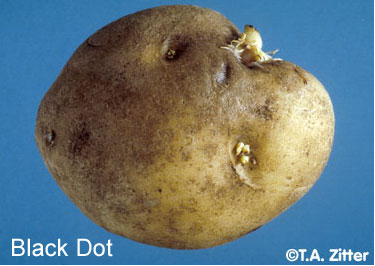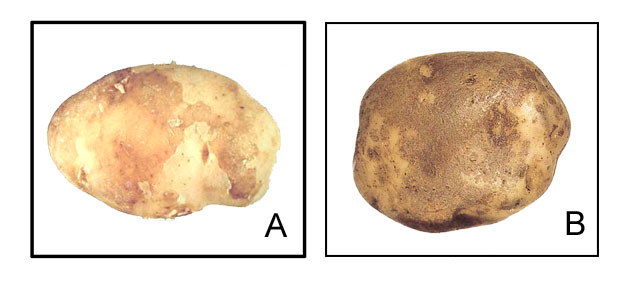During my 35 plus years involved in the inspection of fresh fruit and vegetables I never came across Black Dot on potatoes. Not one potato shipper or receiver ever complained or mentioned Black Dot to me. But during the past two years, the USDA has made it a point to include Black Dot as a topic of discussion for their annual refresher training classes.
Every year, the USDA’s Training and Development Center Staff create and host refresher training classes for every federal and federal state terminal market inspector within the country. The staff will try to highlight important topics, or defects that are being seen as a common occurrence. These refresher classes allow the inspectors to discuss the defects they are seeing and to review the proper scoring guidelines. Such topics may include, hollow heart on watermelons, yellowing on limes, tipburn on lettuce, abnormal coloring on tomatoes…..all defects commonly found by inspectors.

The image above depicts Black Dot. The medium brown discoloration is typical of this defect. Black dot is caused by a fungus, Colletotrichum coccodes, and with closer examination, the discolored area reveals the presence of dot-like sclerotia of Colletotrichum. The sclerotia can easily be seen with a hand lens. I hope the USDA is not planning on issuing magnifying glasses to every inspector to help them identify this defect.
You may have seen this defect but called it Silver Scurf. It looks very similar to Black Dot. In most growing seasons you may come across this defect. Silver Scurf is also caused by a pathogen, Helminthosporium solani, which has a characteristic silver sheen, especially when wet. The USDA has a specific scoring guideline for Silver Scurf. Silver Scurf is to be scored as damage when the affected area exceeds 50% of the surface.
I am not sure why the USDA has devoted 2 cycles of their annual refresher training to talk about Black Dot on potatoes, but if you start seeing this defect showing up on your inspection certificates you will know the reason. It looks basically like Silver Scurf, which you have probably heard of for years.
But leave it to the USDA. They have recently issued changes to their inspection instructions. Not a change to the U.S. Standard, which would allow for public comments, but the USDA has made an administrative ruling all on their own, with no input from industry. Now remember, the Fresh Products Inspection Branch is comprised of only 125 employees. Apparently a couple of these USDA managers decided it was time to add a scoring guideline for Black Dot to their inspection instructions.
Here is their new guideline:
“When encountering staining or diseases like Black Dot, describe the defect and report as discoloration.
Scoring Guide:
DAMAGE:
When affecting more than 30% of the surface by light tan or light brown colors which do not blend, or
When affecting more than 15% of the surface by darker than light tan or light brown colors.”
Now take a look at the potatoes below;

Potato A- this is a potato with surface discoloration, which the USDA decided to use as a comparable scoring guideline. for Black Dot.
Potato B- this is silver scurf. The USDA decided not to use this comparable scoring guideline for Black Dot.
In fact, the image shown above, of Black Dot, actually depicts a potato with both Black Dot and Silver Scurf.
Can you tell which defect is which?
(Silver Scurf can be seen directly under the large sprout.)
To summarize:
- The USDA has taken it upon themselves to train their inspectors during the last two years on a defect that has never been an issue in the potato industry.
- In lieu of meeting with industry members, growers, shippers, wholesalers and retailers, they decided a few of them know what is best for the industry.
So what will be the fallout from this decision?
- USDA inspections will now be reporting the defect “surface discoloration” on their certificates. The person reading the certificate will not know if the inspector found Black Dot, or typical surface discoloration, as show by Potato A.
- And more importantly, the USDA will find potatoes with silver scurf, but because the scoring guideline for silver scurf is much looser, it would not be a defect, so the inspectors may mistakenly call the defect “surface discoloration” which would now be a defect according to their scoring guideline. A real lose/lose for the grower/shippers.
What is the answer? A few years ago the Fruit and Vegetable Advisory Group required the Fresh Products Branch of the USDA to notify their group of any administrative decisions regarding defects and their scoring guidelines. It seemed to work well, and everyone in the industry had an input in these decisions.
If you would like to read more about Black Dot, please click here.

2 Comments on “Potatoes- Black Dot”
Thank You very much for photo of deseased tubers and these publications.
This is my first time go to see at here and i am
really pleassant to read all at single place.